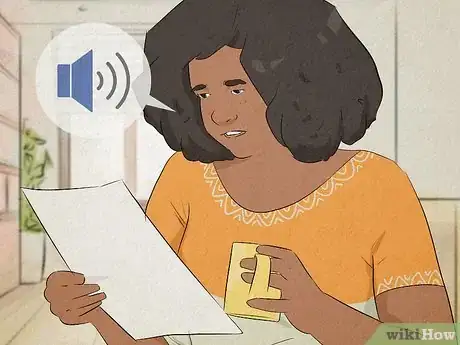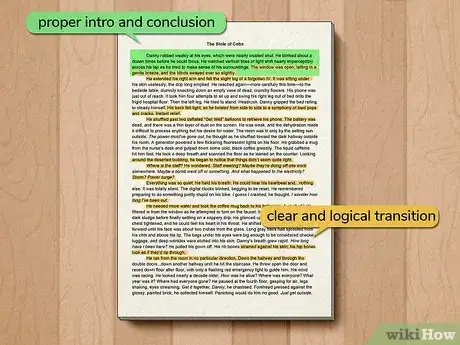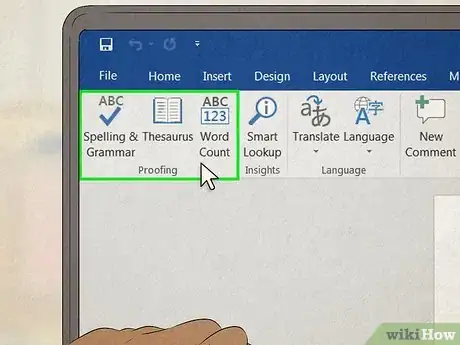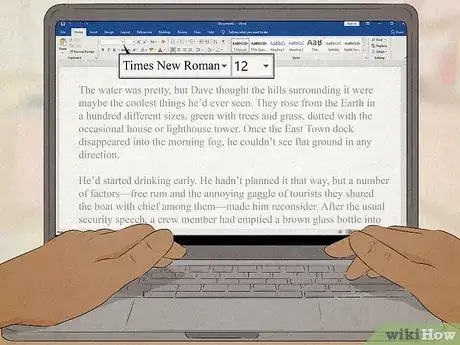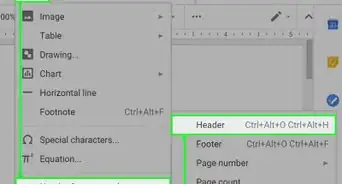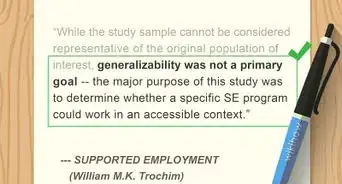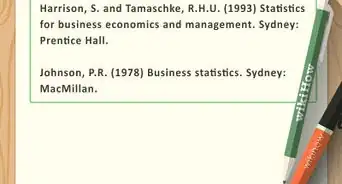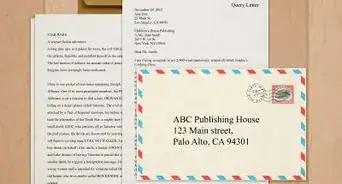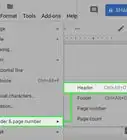This article was co-authored by Michelle Golden, PhD. Michelle Golden is an English teacher in Athens, Georgia. She received her MA in Language Arts Teacher Education in 2008 and received her PhD in English from Georgia State University in 2015.
wikiHow marks an article as reader-approved once it receives enough positive feedback. In this case, 80% of readers who voted found the article helpful, earning it our reader-approved status.
This article has been viewed 33,092 times.
Once you've finished writing a manuscript, you're ready to move on to the editing stage. Editing is the process of rereading your first draft to look for places that need revision and making changes as needed.[1] Whether you're writing a book, an essay, a short story, or an article for submission to a scholarly journal, your manuscript will need to undergo some revision before you send it to a publisher. Editing involves proofreading, but it goes much further than that. Learning how to edit a manuscript can help you get your writing project ready for submission and publication.
Steps
Preparing to Edit
-
1Wait for a fresh read. If you've just finished writing your manuscript, you're probably feeling a well-deserved sense of accomplishment. When you're attached to your work immediately after completing the manuscript, it can be very difficult to distance yourself from your work enough to make the necessary cuts and revisions. Rather than trying to jump right into the editing phase after completion, it's best to set your work aside for a while so you can approach it with a fresh set of eyes.[2]
- A fresh read allows you to effectively view the manuscript as if you were reading someone else's work, which can make it easier to distance yourself from your own words.
- If at all possible, give yourself at least a week without reading or working on your manuscript in any way. If you can give yourself a few weeks it may be even better.
-
2Print the manuscript. When you're ready to sit down and begin editing, it may be helpful for you to have a hard copy printed out. Seeing your words on the computer may force you to see the work as you did while you were writing it - in other words, things that made sense to you in your head may read differently when viewed as a final product.[3]
- Some writers find that reading words on a printed page makes it easier to spot mistakes, weak spots, and poorly-written passages.
Advertisement -
3Give it a dry read. Before you actually get down to editing the manuscript, you may find it helpful to read through it once as though you were a reader picking up a printed book. Don't make any changes to the manuscript while you're reading through it - you're still in the preparation stage. Simply make notes in the margins when you find a section that is confusing or poorly written so that you know where to focus your attention when you return to the manuscript.[4]
- Aim to simply get an overall impression of the work as a whole.
- Think of yourself as an outside reader. Try to get through the entire manuscript in no more than three or four readings so that you can take in the piece as a complete work.
- Were there any parts of the manuscript that feel incomplete or confusing? Make note of those sections, but don't worry about revising them yet.
- What were the strong/compelling/interesting parts of the manuscript? Mark those so you know what you're most reluctant to cut.
-
4Read your work out loud. Reading aloud can help you hear the words instead of simply seeing them. Many people find that hearing words spoken out loud makes it easier to catch errors. [5]
- Reading aloud also makes you slow down, which could be another reason that it is easier to catch errors.
Making Revisions
-
1Revise the content. Go back through the manuscript with a fine-toothed comb. Is there anything about the actual content that is not working? For fiction, are there any plot holes or places where the narrative falls apart? For creative nonfiction (memoir, essay collection, reportage), are there any gaps in your work where perhaps something that made sense to you may not make sense to an outside reader? For a scholarly manuscript, does the research clearly support your conclusions?[6]
- Are there any conclusions your writing jumps to that may not make sense to a reader?
- Does everything in the manuscript make sense? Is everything consistent from start to finish? If you have a thesis or central argument, is it complete and sufficiently supported?
- Are your characters realistic and believable? Are they interesting and complex, or do they fall flat and two-dimensional?[7]
- For nonfiction works, are you presenting each individual fairly and honestly?
- Are there enough sensory details in the manuscript? Does the narrative come to life and draw you in?
- Make revisions as necessary to satisfy these and any other points of concern within the manuscript.
-
2Work on the structure. If you're writing a scholarly submission, you'll need a proper introduction and conclusion. If the manuscript is a creative work, it will need a compelling beginning and a strong ending. And on a page-by-page level, the entirety of the manuscript should be arranged with a clear and logical progression that leads the reader naturally from the beginning to the end.[8]
- Look for transitions that guide the reader from one paragraph to the next. If your transitions are weak or lacking altogether, compose a sentence or two that will serve as a transition to the next paragraph.
- When you were reading through your manuscript, did you find yourself losing interest at any point in the middle of the work? If so, perhaps you need to restructure the body of the manuscript. You may have loaded all the strong sections at the beginning and ending and forgotten to focus on the body of the piece. Rewrite these sections as needed.
-
3Make changes at the sentence level. Once you've taken care of the larger issues like plot and structure, you'll need to take a close look at the language that you use in each line. Look for consistency in your line work and strong, well-polished sentences.[9]
- Make sure that the point of view and tense stay consistent. Don't suddenly jump from one person's perspective to another, or from past tense to present or future tense.
- Are there any awkward sentences that are confusing, clunky, or just poorly written? What about run-on sentences? Never-ending paragraphs? Remember that readers tend to prefer short, action-packed paragraphs instead of long-winded, drawn-out ones.
- Look for and replace/remove "crutch words" - those words and phrases you tend to fall back on out of comfort or over-reliance. Instead, try rephrasing those sentences with fresh, original prose or cutting these parts out altogether.[10]
- Find any sentences that are unnecessary ("filler" lines) and cut them out. No matter how much you may like the way you composed a line, if it's not essential and doesn't contribute to the plot or to any character's development it's a waste of space.
-
4Consider getting outside feedback. No matter how thoroughly you edit your manuscript, there may inevitably be some issues that you are blind to. That's where having an outside reader can come in handy. If you want a professional editor, you can search for editing services online. You can also ask someone you know and trust to review your work, but it should be someone who is capable of giving you objective feedback. It's best to avoid asking parents or significant others for feedback, as they may have a hard time looking past your relationship to find issues that need to be improved. Ask your reader/editor whether:
- your manuscript makes sense
- your ideas are clear and well-organized
- the transitions between ideas, sentences, and paragraphs are all smooth and well-executed
- your writing style is appealing and easy to engage with
- there are any grammatical, syntactical, or formatting issues[11]
Formatting Your Manuscript
-
1Spellcheck your manuscript. If you haven't kept your computer's spellcheck function on during the writing process, turn it on now. Run a spellcheck for the entire document and look for any misspellings, improper use of capital/lowercase letters, and grammatical errors. Correcting these mistakes will help make your manuscript look more professional and polished, and could be the difference between a publisher's approval and rejection.[12]
-
2Use only single spaces. Many people learned to type by putting two spaces after each period. Today, however, most editors and publishers (with relatively few exceptions) only use a single space. Having two spaces after each punctuation mark forces the editor to comb over your entire manuscript and take out the unnecessary spaces. You can save your editor a lot of time and effort (and thereby make your manuscript more appealing) by using the conventional method of only one single space after punctuation marks.[13]
- If you need to remove extra spaces throughout your manuscript and you're using Microsoft Word, you can use the "find and replace" function. Simply navigate to "Edit," hover your mouse over "Find," and click "Replace." In the "Find what" section, type the space bar twice, and in the "Replace" section, type the space bar once. Then click "Replace All."[14]
-
3Follow requested formatting guidelines. If you're submitting to a publisher, you should have a decent idea of how that publisher wants your manuscript to be formatted. If the publisher hasn't directly communicated her desired formatting guidelines, check the publisher's website. Most publishing houses include guidelines on their website that dictate the font size and style, spacing between lines (usually either single-spaced or double-spaced), indentations, margins, page breaks, and page numbers.[15]
- The standard font type is Times New Roman with a 12-point font.
- Many publishers want page numbers, but not all do. For those that do, they may request that the numbers be printed in the top right, bottom right, or bottom center of the page.
- If you're submitting a scholarly manuscript, be sure that your citations are formatted the way the publisher wants them.[16]
Finalizing the Manuscript
-
1Give it another read. Now that you've made changes to the sentences, structure, and plot of your manuscript, taken out unnecessary portions, and reformatted it as necessary, read through the manuscript again. You'll certainly notice a lot of improvement, but try not to get caught up in how much better the manuscript is. Instead, look for any places that may need further revisions, and focus on polishing those sections as well.
-
2Get an outsider's opinion. If you feel comfortable sharing your work with someone else (a trusted friend or family member, for example), do so. Just as you needed to have fresh eyes before you could begin revision, the freshest eyes belong to an outside, unbiased reader. There may still be parts of the manuscript that make sense to you in your head, but to an outsider would be confusing, unclear, or simply unlikeable.[17]
- Let your reader know that you want an honest, thorough assessment of the manuscript. Tell your friends to save their praise for when the manuscript is published, and let them know that you want useful, thoughtful feedback on what needs improvement.
- If you feel that the feedback you get is valid, make any necessary changes to the manuscript. Remember that it's normal for most manuscripts to go through numerous extensive revisions before being published.
- Treat your friends to a nice meal or a bottle of their favorite liquor (assuming you're both old enough to legally drink) to show your appreciation.
-
3Submit your work. When you feel that your manuscript is well polished and complete, it's time to try and publish it. If you have an editor or agent, submit your work to that person. If you're sending it to a publisher, confirm that that publisher is currently accepting new manuscripts. Be sure to include a letter of thanks to show your appreciation for the editor/agent/publisher's time and interest, and show thanks to anyone else who's helped get your manuscript to the publication stage.
Community Q&A
-
QuestionWhat is the average cost of editing a young adult novel ms of about 45,000 words?
 Nathan FeldCommunity AnswerThat really depends on the editor and cost. Typically the cost is from $0.014 to $0.032 per word, so the cost would be between $630.000 and $1440.00, but this can vary.
Nathan FeldCommunity AnswerThat really depends on the editor and cost. Typically the cost is from $0.014 to $0.032 per word, so the cost would be between $630.000 and $1440.00, but this can vary. -
QuestionCan manuscripts be used for fiction writing?
 DonaganTop AnswererYes. A manuscript is typically produced in the writing of any kind of book.
DonaganTop AnswererYes. A manuscript is typically produced in the writing of any kind of book.
References
- ↑ http://writingcenter.unc.edu/handouts/editing-and-proofreading/
- ↑ http://thewritelife.com/self-editing-basics/#.xzya1vc:sAb7
- ↑ http://thewritelife.com/self-editing-basics/#.xzya1vc:sAb7
- ↑ http://www.writersdigest.com/qp7-migration-books/wgf-revision_excerpt
- ↑ http://writingcenter.unc.edu/handouts/editing-and-proofreading/
- ↑ http://writingcenter.unc.edu/handouts/editing-and-proofreading/
- ↑ http://www.writersdigest.com/qp7-migration-books/wgf-revision_excerpt
- ↑ http://writingcenter.unc.edu/handouts/editing-and-proofreading/
- ↑ http://www.writersdigest.com/online-editor/what-to-look-for-when-editing-your-manuscript
- ↑ http://thewritelife.com/self-editing-basics/#.xzya1vc:sAb7
- ↑ http://writingcenter.unc.edu/handouts/getting-feedback/
- ↑ http://thewritelife.com/self-editing-basics/#.xzya1vc:sAb7
- ↑ http://thewritelife.com/self-editing-basics/#.xzya1vc:sAb7
- ↑ https://askdrexel.drexel.edu/app/answers/detail/a_id/2330/~/how-to%3A-use-the-find-and-replace-feature-in-word-2007.
- ↑ http://thewritelife.com/self-editing-basics/#.xzya1vc:sAb7
- ↑ http://writingcenter.unc.edu/handouts/editing-and-proofreading/
- ↑ http://www.writersdigest.com/qp7-migration-books/wgf-revision_excerpt



